
Aseptis fumosa is a moth of the family Noctuidae first described by Augustus Radcliffe Grote in 1879. It is widespread in western North America and is known from western Canada, Washington, Nebraska, Colorado, Utah, Arizona, Nevada and California. It occurs in a variety of diverse habitats including coast chaparral, dry conifer forest, and shrub steppe.
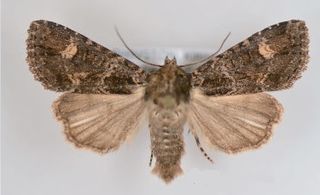
Aseptis binotata, the rusty shoulder knot moth, is a moth of the family Noctuidae. The species was first described by Francis Walker in 1865. It is found widespread in western North America, west of south-central Alberta, Wyoming, and Nebraska. Along the Pacific Coast it occurs from northern Mexico to south-central British Columbia. It can be found from sea level to altitudes over 2000 meters in a variety of habitats from dense forest to shrub desert.

Paraseptis is a monotypic moth genus in the family Noctuidae erected by Tomas Mustelin and Lars G. Crabo in 2015. Its only species, Paraseptis adnixa, was first described by Augustus Radcliffe Grote in 1880. It is widely distributed along the Pacific Coast from northern Mexico to south-western British Columbia in a variety of forested habitats.
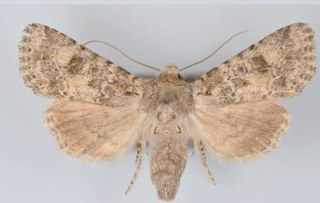
Aseptis catalina is a moth of the family Noctuidae first described by John Bernhardt Smith in 1899. It is found in the deserts of Arizona, California and Baja California in Mexico.

Aseptis ethnica is a moth of the family Noctuidae first described by John Bernhardt Smith in 1899. It is found in North America in Arizona, California, western Oregon, and Baja California Norte in Mexico. The habitat consists of open pine and oak forest and mountain chaparral, mostly at elevations of above 1500 meters in southern California but at lower elevations farther north.

Aseptis characta is a moth of the family Noctuidae first described by Augustus Radcliffe Grote in 1880. It is widespread in western North America, where it is found in the western Great Plains, Great Basin, and Pacific regions from British Columbia, Alberta, and Saskatchewan to Colorado, Utah, northern Arizona and southern California. The species occurs in dry habitats like sagebrush steppe, juniper woodlands, and open forest from sea level to 2,500 meters.

Aseptis fumeola is a moth of the family Noctuidae first described by George Hampson in 1908. It is found in the US state of Arizona, southern and central California, southern Nevada and south-eastern Utah. The habitat consists of foothills and mountains in dry chaparral, parkland, and conifer forest.
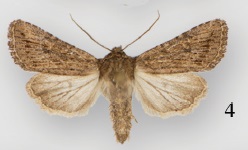
Protorthodes eureka is a moth in the family Noctuidae first described by William Barnes and Foster Hendrickson Benjamin in 1927. It is found in North America from southern Alberta southward in the western Great Plains to Colorado and in the Great Basin to east-central California and south-western Colorado. The habitat consists of open xeric habitats, especially sagebrush prairie and open pinyon-juniper woodlands.

Protorthodes texicana is a moth in the family Noctuidae first described by J. Donald Lafontaine in 2014. It is known from west-central Texas and southern Mexico.
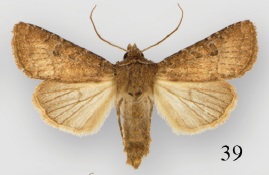
Protorthodes ustulata is a moth in the family Noctuidae first described by J. Donald Lafontaine, J. Bruce Walsh and Clifford D. Ferris in 2014. It is found in North America from south-eastern Wyoming southward to the Guadalupe Mountains in western Texas and westward to central and south-eastern Arizona and northern Mexico.

Aseptis murina is a moth of the family Noctuidae first described by Tomas Mustelin in 2000. It is found in the US in southern California, where it occurs in coastal chaparral, foothills, mountain brush land and oak forest, and in the mountain-desert transition zone from sea level to 2000 meters.

Aseptis ferruginea is a moth of the family Noctuidae first described by Tomas Mustelin in 2000. It is endemic to southern California. All records are from San Diego County, from an area between Boulevard-Manzanita near the Mexican border north to Lake Henshaw at altitudes of 800–1600 meters. The habitat consist of open oak forest, foothill chaparral, and in the mountain-desert transition zone.

Aseptis fanatica is a moth of the family Noctuidae first described by Tomas Mustelin in 2006. It is found in western North America in Washington, Oregon, California, and Baja California Norte in Mexico. It is found in habitats like brush land and open forest in southern California, mostly at 1000–2000 meters, but occurs at lower elevations farther north.

Aseptis lichena is a moth of the family Noctuidae first described by William Barnes and James Halliday McDunnough in 1912. It is found in the United States in south-central California and north-central California. It is also reported from Mount Shasta, Mount Lassen, and other locations in northern California.
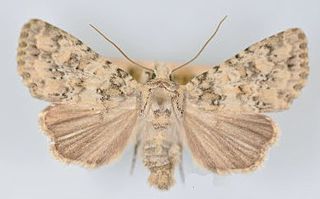
Aseptis pseudolichena is a moth of the family Noctuidae first described by Tomas Mustelin and Ronald Henley Leuschner in 2000. It is endemic to southern California, with records from San Diego, Riverside, Los Angeles, Ventura, San Bernardino, and Tuolumne counties. The habitat consists of open pine and oak forest, open areas with grass and scrub, and foothill chaparral.
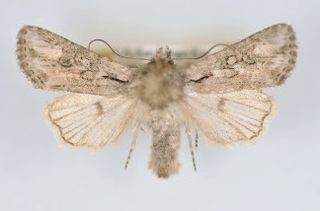
Aseptis torreyana is a moth of the family Noctuidae first described by Tomas Mustelin in 2006. It is found in along the south side of the sea level salt marsh estuary of the Torrey Pines State Reserve in southern California. The habitat is most likely salt marsh, although it could be coastal chaparral.
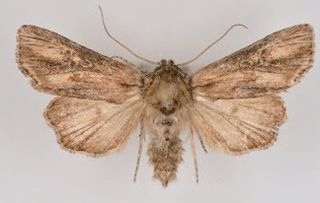
Aseptis susquesa is a moth of the family Noctuidae first described by John Bernhardt Smith in 1908. It is found in Arizona, California and Baja California in Mexico, at least as far south as Ensenada. The habitat consists of rocky areas in the mountain-desert transition zone and high desert.
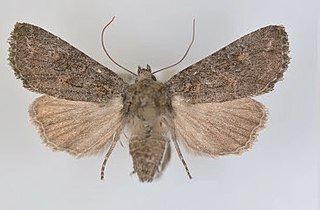
Aseptis perfumosa is a moth of the family Noctuidae first described by George Hampson in 1918. It is endemic to southern California, where it occurs in many habitats such as coastal chaparral and canyons, urban areas, brush land, and open oak forest from sea level to 2000 meters.
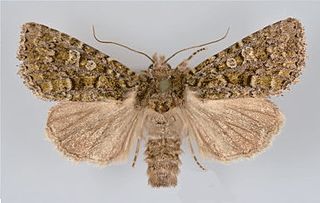
Viridiseptis is a monotypic moth genus in the family Noctuidae erected by Tomas Mustelin and Lars G. Crabo in 2015. Its only species, Viridiseptis marina, was first described by Augustus Radcliffe Grote in 1874. It is found throughout coastal California and in south-western Oregon as far north as Douglas County. It is widely distributed in southern California. It is found in many habitats such as coastal chaparral, mountain forest, mountain-desert transition zone, and occasionally in the deserts from sea level to at least 2000 meters.

Macronoctua onusta, commonly known as the iris borer, is a species of cutworm or dart moth in the family Noctuidae. It is found in North America.





















